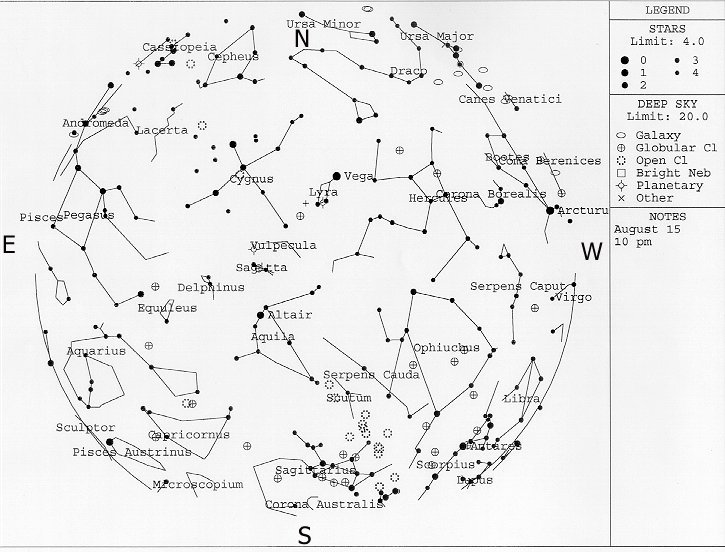What's to see in the night sky in August?

This chart represents the sky as it looks at around 10 PM local
time. Some adjustment should be made for longitude, but it shouldn't be much. Right click on
the chart, select "Save As" and save the image. You can then print
this chart from a photo application, like Print Shop Pro, hold it in front of you with the
direction you are facing at the bottom. Then, raise it above your head and you should be
able to find your way around from there.
Moon phases
New-8/12_____First Quarter-8/20____Full-8/28____Last Quarter-8/5
Planets
Mercury is pretty much lost in the Sun this
month.
Venus begins the month approaching the Sun, so she won't be visible
until next month.
Mars The red planet rises in the east
Jupiter enters August near the meridian after
sunset and well placed in Scorpius.
Saturn will be hiding close to the Sun for a
while, and so is lost to observers until.
Meteor showers
The Kappa Cygnids and Iota Aquarids
are active this month, if you could call it that. They are barely detectable
above the background at only 3 ZHR.
But the Alpha Aurigids
towards the end of the month show about 10 ZHR, peaking on the 31st.
The Perseids peak on the 12th. Again, right
on the new Moon, so it could be great seeing these fastest of meteors. This
shower has given some spectacular displays in the past. Maybe watch for
them the week before they peak.
Deep Sky Objects (DSO's)
Messier Objects
Globs M55, 54, 69, 70, 22, 28 and almost 75, (you can almost see it, that is. ;-)),
all in Sagittarius, plus M71 in Sagitta, plus M56 in Lyra. And you thought the only thing in
Lyra was the ring, huh?
Open clusters are almost too numerous to mention, but M11, 18, 21, 26, 23, 24 and 25 are all
great. Maybe hard to isolate, what with the center of the galaxy right there, but still...
For some reason, some of the best nebulae in the sky are classified as "clusters, with
nebulosity". Namely, M8, 20, 16, 17 and 18. These are AKA the Lagoon, the Trifid, the Eagle,
and the Swan, respectively. Although the clusters are wonderful, I'm not sure they compare
with the wonder of the nebulae that spawned them. Must be politics.
This particular region of sky holds two of the most spectacular planetary nebulae in the sky.
M27, the Dumb bell and M57, the Ring. What surprises me though, is the amazing difference in
size between the two. The ring is bright yes, but tiny when compared to the Dumb bell. (Check
out the Messier page to see the difference for yourself.)
Galaxies-You may say there are none, but all you have to do is look up-our own Milky Way is
the largest visible edge-on in the sky! See the dust lanes, HII regions, globulars and
everything. You just have to adjust your perspective a bit and think on a larger scale. :-)
Named DSO's
The blinking nebula in Cygnus, (Ngc 6826), is cool in a telescope. Look directly at it, and it seems to shrink. Look to the side and it expands-a great illustration of "averted vision". The Cat's Eye nebula (Ngc 6543), is close by in Draco, almost due north of Vega. Both are great planetaries.
This doesn't really have a name, but I think it's a really nice area, if you have low horizons. Look in Sagittarius for the Teapot asterism. Below the handle is a group of stars that form a curve starting to the east, then south, then back west. They're at the same altitude as the "stinger" stars in Scorpius. This is the consellation Corona Australis. The top two stars hold a number of interesting objects, all within a couple degrees. The first is a globular cluster, NGC 6723. Just to the east and south, and almost in the same field of view is a double star, HR 7169 and HR 7170, they are almost the same color and brightness. To the north of these is a small cluster of stars, with lots of nebulosity associated. It should appear as kind of a fog. If you have a rich field telescope or high power binoculars, you may pick up the dark nebula in this area too, BE 157.
This whole region of sky is perfect for just sitting back on a lawn chair and surfing with binoculars. I highly recommend it! Enjoy. And let me know what you see!
Here's the link to SEDS as promised.
| January's page | February's page | March's's page | April's page | May's page | June's page |
| July's page | August's page | September's page | October's page | November's page | December's page |

Copyright 1999, Steve Dodder
Webmaster: Steve Dodder
Revised: 1/24/00